Everybody talks about how great Facebook ads are for driving new leads and customers to your business. And the ads themselves are simple enough to set up, right?
So you’re running your first campaign. It’s nice to see your own face in the news feed, isn’t it?
Now what?
The whole point of a campaign ISN’T just getting your ad shown in the news feed. You’re spending money to generate traffic, leads and sales.
Your ads have to work. Otherwise you’re just wasting your money.
In this guide, I’m going to teach you, step-by-step, how to create, test and implement engaging, creative, professionally-crafted facebook ads with ridiculously high clickthrough and conversion rates — WITHOUT breaking the bank.
Even if you’re not a master copywriter or designer.
Even if you’ve tried Facebook ads in the past, and the results were “meh.”
This post is for you if:
- You’ve run Facebook ads in the past, but have been “turned off” because they didn’t seem to work.
- You’re a new marketer who doesn’t have $200,000 of ad spend to “play with,” and you want to know what elements you can tweak to give your campaign the greatest ROI for the least amount of money
- You’re an experienced marketer looking for fresh ideas to keep your campaigns engaging
- You like tacos
NOTE: This post should be used to optimize your ad results to get you much better results for much less money. If you’ve never run a Facebook campaign before, definitely read Noah’s beginner post, implement, then come back. It’ll all make much more sense.
Keep reading!
3 Elements of a High-Converting Facebook Ad
In the beginning, lots of junior marketers freak out because they’re unsure about their own copywriting and design skills.
“What should my ad say?”
“What should it look like?”
Thank God, none of that matters (right now).
If you thought that creating a good ad was mostly about putting together a cute picture and nice tagline, you’re wrong.
In fact, the creative portion of your ad — while it IS very important — is probably the last thing you should consider when trying to set up a campaign that actually achieves your objectives (a click, a sign up, a sale, etc).
A killer ad consists of three primary elements. Roughly, in order of importance:
- Audience: who you’re targeting for your ad
- Offer: what you’re offering the audience
- Creative: what the ad says and what it looks like
Let’s break down each element.
Element #1 — Finding an audience that is guaranteed to convert
Finding your audience is the MOST important element of every campaign because if you show a crappy ad to the right people, it will STILL work better than the most beautifully crafted, poorly targeted ad at people who don’t give a sh*t about what you’re selling.
Correct targeting is paramount.
Even in the basic ad manager, Facebook has some incredible tools to find who you’re looking for and target them by various demographics. In the power editor, you can get even nitty grittier.
Like many things in life, size is indeed an important factor here.
You want to find an audience that’s small and specific enough to be interested in your promotion, but big enough to actually make an impact.
There are two sides to this equation:
On one hand, left to their own devices, Facebook would have you to target every single person in the galaxy if they could. Their default setting has you targeting 176,000,000 people
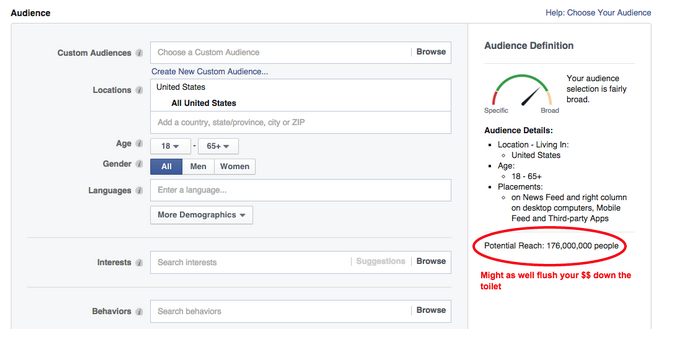
Marketing to an audience this big is like shot-gunning your resume to every employer in the United States, even though you want to work somewhere close to home.
Pointless.
Facebook’s goal is to take your money, and the more times your ad gets shown, the more you spend. They don’t really care if your business gets a positive return. Obviously, this is no bueno. There has to be SOME precision with your targeting.
On the other hand, some marketing experts might tell you that you need to get HYPER specific and pare down your audience to a niche list of like 4,500 people to make sure that they’re really interested in your offer.
I’ve tried that before as well and the results were less than stellar:

If you try to make your audience TOO specific, it can backfire as well.
In the ad above, I uploaded a custom audience full of people who were supposedly right in my niche.
I had a list of 5,000 freelancers to advertise my freelancing webinar to. The countries, language and ages were dialed in tight. Imagine a room full of 5,000 prime targets, ready to receive my message! Perfect, right?
The result: I spent over $36 for a paltry 3 webinar registrations. Not sustainable at scale.
At $12/conversion, that’d be $12,000 for 1,000 registrants. The price per conversion didn’t match up with what I needed to run a successful campaign. The audience was just too small to produce meaningful results at an affordable price.
You can also see that with an audience so small, the “frequency” of the ad (the number of times people see it) climbs relatively quickly. That 3.88 in the top bar means that on average, each person had seen my ad 4 times. It was getting a little stale.
(Ever see an annoying ad that just won’t go away? Are you more or less likely to click on it the 20th time you see it? Exactly.)
So what’s the answer? Broadly focused or hyper targeted? My answer: Yes.
Both scenarios CAN work. After multiple tests, I’ve found the right audience size may be anywhere from 5,000 to 300,000 people. You’ll just have to test what works for each campaign.
How to test your targeting to see if it’s working
I’d suggest starting with 3-4 audiences that you think share a common interest with your brand, or the promotion you’re running.
The goal is to run multiple identical ads, changing only the audience, and note how they react. Then, you can check which audiences are converting and use that audience as the base for your next round of testing.
(This is bringing back memories of chemistry lab and controlled variables.)
Here’s the ad:

I created the ad, then tested the exact same copy/image to 6 different audiences. Some were broadly focused, some were more niche. Within 24-48 hours, it becomes really clear which audiences are responding the best to this particular ad.

Notice that trend? For this particular campaign, the advertisement with the largest audience/reach (GoPro6) is outperforming other more targeted audiences by 10x.
Here’s the audience selection for that ad:

With an audience size of over 250,000 people, and very loose targeting based on a single interest, this audience still had:
- One of the highest conversion rates (.682%)
- The second cheapest price per click ($0.65)
- The most clicks (104)
After running this test, now we know that this audience is well targeted and we can keep this variable in place while we test other elements of the campaign to make it convert even better.
But here’s the thing…
After you’ve perfected your targeting, you need to focus on tweaking the offer. The sweeter the offer is to your target audience, the more likely they’ll be to convert.
Element #2 — Choosing the correct offer for your audience
There are lots of different things you can offer that make people click, sign up or buy from you on Facebook.
A quick scan of my news feed shows a bunch of different offers right now, targeted to me based on several factors:
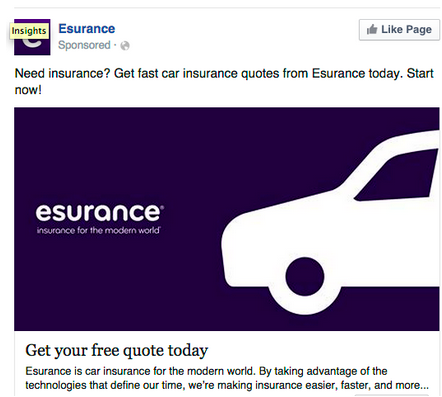

You’ll get tons of different offers in your newsfeed. Some free, some paid. Some online, some in person. They can all convert if paired with the right audience.What I’ve learned over the past few months is that the size of your ideal audience and your offer have to go hand-in-hand to work effectively.
For instance…
If you’re a local restaurant and you want to promote your Friday happy hour, maybe you’ll run an ad that provides a two-for-one coupon when the user clicks through to a landing page. In this case, it makes sense to drill down fairly close to your audience. Your offer is for something specific, regional and time-sensitive.
Your targeting could include:
- Location: 10-15 mile driving distance
- Age: 13 year olds aren’t legal, 65 year olds probably aren’t as interested
- Time frame: Thursday and Friday
- Interests: Other restaurants in the area similar to yours
After inputting all this info and anything else you deem relevant, you might find the resulting audience to be anywhere between 10,000 and 50,000 people. And that’s totally fine.
Each new targeting factors makes your audience smaller and smaller — but it makes sense because a targeted offer matches a targeted demographic.
On the other hand, if your offer is something more general (like the GoPro Giveaway above) it will fit more audiences, and you can open up the targeting a little bit. 50,000, 100,000, even 200,000 people may be ok to target, as long as the offer makes sense.
What type of things should you offer people?
From physical products, to events, to free information, to contests — any offer can work when presented to the right audience. That’s why selecting your audience is first on the list.
Ideas to offer your audience:
- Free subscription to your newsletter
- Giveaways*
- Coupons to local businesses
- Limited time offers
- Free consultations
- Event access (free and paid)
- Free trials (works great with software)
- “Just cover shipping” samples
- Ebooks/PDFs
Pro tips for contests and giveaways
Giveaways are very effective at generating leads and I wanted to add some specific tidbits I’ve learned recently.
I’ve tried a bunch of different software to facilitate contests/giveaway, including the very popular Contest Domination. So far, KingSumo’s Giveaways has better shareability and virality — and is priced better.
Some pointers when running contests:
- Optimize for clicks. You’ll get a much better deal than optimizing for conversions.
- Target a broad audience. >50k if possible….and connect them to pages and interests that relate to the giveaway. Start with 3-4 audiences to test.
- Use the word “giveaway” in the title so that it shows on social
- After the frequency starts climbing high in the first few audiences that you target (avg frequency 2-3) open up some new audiences
- Refresh the ad with different creative after a few days running it hard
- One thing I’m going to test: exporting registrants straight from the plugin, then making a custom audience in FB and hitting them with something like “You’ve already registered. Share this and instantly get 5 more entries in your name…” or something like that. I think it’ll work even better towards the end.
The reason that optimizing for “conversion” is so much more expensive than optimizing for “clicks” is because it takes Facebook more work, more displays, etc to get someone to actually click through and ensure a sign up, rather than just clicking and possibly bouncing.
Optimizing for clicks is just paying Facebook for your target audience to “browse,” whereas optimizing for conversion is paying to ensure that they “buy.”
You can just as easily track your conversions in Google Analytics by seeing how many people sign up for the contest, and dividing that by how many people hit the contest page.
These types of hooks will work in almost any industry, as long as you are targeting correctly and your offer is framed in a way that compels the user to click through and take the action you want them to take (click, sign up, buy, etc).
So let’s talk about framing the offer. You’ve found your audience and you’ve selected something you think they’ll like. You’ve set up a simple ad with a picture and some text. Great! But how do create an ad that delivers results consistently, stands out from the crowd and stays “fresh”?
How do you nail the creative?
Element #3 — Making kick ass creative that gets results
Picking pictures and writing headlines is the fun part of the ad process — but it’s the last thing we should be thinking about.
If we have our audience and our offer down after a few rounds of testing we should have a pretty good idea of who they are and what they want. Now it’s up to us to make something that is visually appealing and speaks to your prospect.
Excellent. We can test the hell out of this.
I’ll steal Noah’s so that we can refresh ourselves on the different components of an ad:

When it comes to creative, I lump copy and design together — but the reality is that since the picture takes up so much of the ad space in a Facebook ad, it’s slightly more important than the copy.
(Copy nerds, don’t freak out. I’m just saying…look at your news feed. It’s all pictures.)
Now we’ll want to start choosing different relevant images and watch the data to see which ads deliver the best results.
Remember what I did with my GoPro campaign?

I started with the basic stock image of the camera, and played around with audiences until I found one that returned results:

The problem is that after a few days, the clicks and conversions started to slow down. This means it was time to “refresh” the ad with new images/copy to re-engage the audience and keep things from getting too stale.
So I had to change out the images. I froze the old ad with the camera image and I picked 3 new ones to test against our control (the original ad). The ads got very minor copy tweaks.
They became ad numbers 8, 9 and 10 respectively.
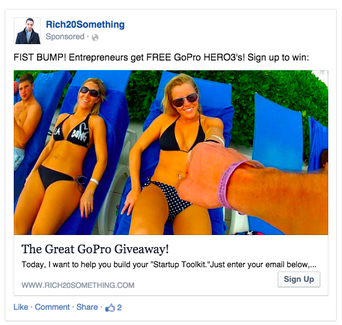
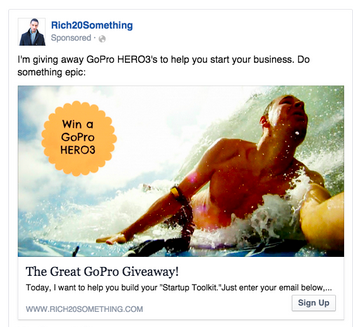

Now, I had a fairly good idea of which ad would perform the best in comparison…but I wasn’t sure. Each picture was chosen for a reason.
#8 is all about girls in bikinis and the unique first person perspective. I was pretty sure that this ad was going to do the best. Because, boobs.
#9 is tropical and fun — but there’s also a neat little orange badge I made withPicMonkey. I wanted to see if it made a difference.
#10 is pretty extreme — and the subject is looking right at the user. Studies show this to be more effective than looking away.
I took the whole test one step further by opening up one more element and testing out a new audience — making a groups called “GoPro8 (b)”, “GoPro9 (b)”, and “GoPro10 (b).”
The results are very clear!

After creating 10 different ads (with 4 different images) we now see very clearly that 3 ads are MUCH more effective than all the rest, and two are the most effective.
GoPro8 (b) is the bikini ad to the alternate audience I tested. GoPro7 is one of the original ads showing just the cameras. You’ll also see that these ads ended up being the cheapest to run!
From looking at these results, I now know exactly which audiences respond the best across multiple iterations, and what images they like the best. From here, I can continue to hone.
How to optimize your own creative
The first thing you’ll need to do in order to optimize your creative is nail down a preliminary audience and offer. You need a baseline to test from.
Got that down? Good.
From here you need to pick new images and copy to see how it stacks up against the baseline.
- Pick 3 new relevant pictures that vary from your original ad
- Choose images with distinctly different features (different subject, angle, colors, graphics) so that your audience can “vote” on which ad they like with their clicks
- Tweak your copy to be simpler and more direct if possible — but keep it consistent across all 3 new ads
- Run those ads for 24 hours and compare to baseline
- After you get preliminary numbers in, open up a new audience for each of your new ads and see what performs the best
- Reanalyze and tweak copy and imagery from your new baseline every few days.
With this process, you can continually refresh the creative in ads your ads based on the data you receive, and incrementally add new audiences to tested advertisements that have proven themselves in other segments.
Wrapping it all up
Yes, Facebook ads CAN be confusing at first. Once you get down the basics, and you learn to optimize the audience, the offer and the creative, you’ll finally start seeing ROI.
As you do more and more of this, you’ll get faster and more intuitive. It won’t take as long to create ads that get results — because you know what you’re doing.
Case in point — I recently thought up this ad in about 10 minutes:
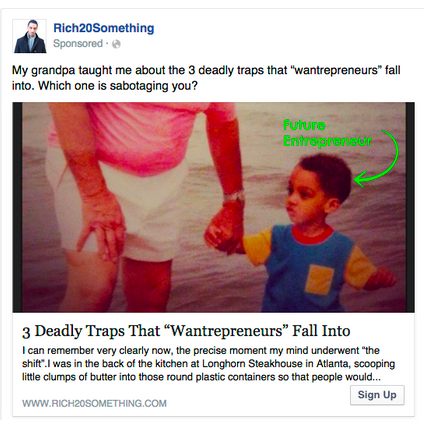
It generated a ridiculous amount of traffic in a short time for less than $0.60 per click. And the BEST part: 1 in 3 people who clicked on the ad ended up converting to my newsletter.
(If you know anything about conversion rate…you know 33% is bananas!)






